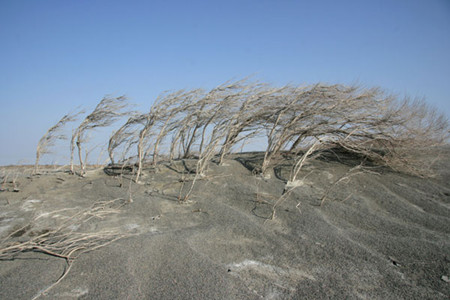
Rose willows struggle to survive along the edge of Aibi Lake, the largest saltwater lake in Xinjiang Uygur autonomous region. Strong wind and salt marshes near the lake make it one of the four sources of sandstorms in China. Wang Kuiping / for China Daily
Xinjiang's picturesque lakes are gradually vanishing and may soon be lost as humans make their presence felt, Shao Wei reports from Urumqi.
Restaurateurs around Chaiwopu Lake, the largest freshwater lake in Urumqi, are in a bit of a pickle. They are losing one of their primary sources of fish, the lake itself.
"The 'big-plate fish' had been one of our specialties," said Ma Xiaohui, owner for 14 years of a small lakeside restaurant. "But the lake has dried up sharply in recent years. Now there are hardly any fish to buy."
Ma said that she actually sees Chaiwopu Lake die slowly every day.
As the water level falls the marshes at its edge turn dry and cattle and sheep no longer graze picturesquely near there.
"The lake used to provide wonderful entertainment," she said. But there's more at stake than beautiful views and fish supplies.
About 3.1 million people live in Urumqi, and "the lake supplies 220,000 cubic meters of water to Urumqi residents every day. The increasing water consumption greatly exceeds the water fed to the lake," said Hu Yongqi, director of the Chaiwopu Lake managerial department in Northwest China's Xinjiang Uygur autonomous region.
Hu has witnessed the changes at the lake during his tenure there. Twenty years ago, the lake covered 30 square kilometers, with an average depth of 4.2 meters, he said. By last year, it had shrunk by nearly 10 sq km and was a mere 50 cm deep at the center.
Moreover, the shoreline has receded 20 meters, and 350 sq km of marshes around the lake have disappeared.
"The lake's ecological system has been severely damaged," Hu said. "With no effective protective measures, the lake will disappear soon. Maybe in 2013, or 2015. Who knows? But it won't be a happy ending for any of us."
Another Lop Nur?
About 500 km away, a wilderness of white, saline-alkali land stretches from the edge of the tracks at Bole railway station, in northern Xinjiang's Bortala Mongolian autonomous prefecture. In the middle of the white lies Aibi Lake, Xinjiang's largest saltwater lake.
"It's not a good time to see the lake, as snow covers both lake and the land into white," train attendant Wang Lihong said. "Come here in summer, and you will see the beautiful lake and even swans from your train seat."
But Wang pointed at the distinct track of the lake's recession and said, "The lake turns smaller and is farther away from the rails."
Gao Xiang, director of the managerial administration of Aibi Lake Wetland Nature Reserve, said the lake is disappearing "at a drastic pace"- about 38 sq km a year. Desertification has claimed more than 1,500 sq km in recent years, reducing the lake area to 530 sq km.
"Now the lake has only one-third of its original size. Some experts predict it will become the second Lop Nur in the near future. I agree," he said. Lop Nur, between the Taklimakan and Kuruktag deserts in southeastern Xinjiang, disappeared 40 years ago.
"But what makes it more worrisome is that the dwindling of Aibi Lake will bring more damage to us than the Lop Nur," Gao said. It has become "a direct threat to the sustainable, economic development of northern Xinjiang".

Copyright ©1999-2011 Chinanews.com. All rights reserved.
Reproduction in whole or in part without permission is prohibited.